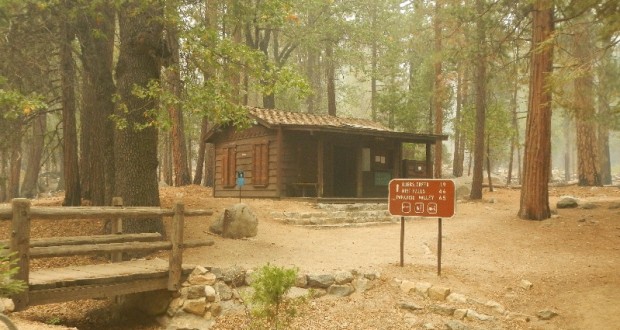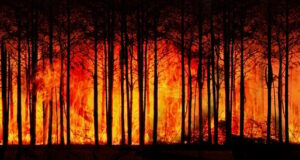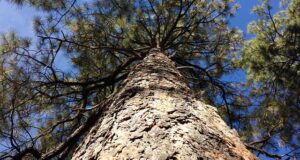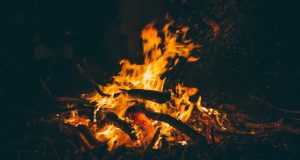Written by John Nichols, Public Information Officer, Rough Fire –
The Rough Fire has been burning for almost two months in rugged and diverse terrain on the Sequoia and Sierra National Forests and the Kings Canyon National Park.
The fire started July 31 from a lightning strike. In the ensuing weeks, the fire grew to over 151,000 acres and at its height, was fought by over 3,800 wildland firefighters.
When cooler weather moved in last week bringing some moisture, firefighters were finally able to successfully contain the beast. Now, 654 firefighters continue the final stages of what little firefight remains, and have been mopping up and further securing the fire containment lines to make it safe for evacuated families to return home.
Inherent in wildland fire fighting, or “suppression” efforts is the amount of surface disturbance that has to take place to construct lines with bulldozers and hand tools around a wildfire to stop its progress. For the Rough fire, over 100 miles of fire line had to be constructed to finally corral the massive wildfire. Additionally, many more miles of line had been constructed in the attempt to corral a smaller fire only to be burned over or around as the fire made its dangerous and spectacular runs. These lines are now in the interior of the 151,000 acre giant.
There was a time in the past when fighting wildfires involved only firefighters whose sole focus was on corralling and stopping a fire. Today, the wildland firefighting forces include a group of highly trained specialists who, while fully fire-qualified and experienced, are on the fire lines NOT to fight the fire, but instead to do a very different job. They are archeologists and biologists assigned as “Resource Advisors” on the lines with the firefighters.
Rocky Opliger, Type 1 Incident Commander responsible for much of the Rough Fire, talked about the Resource Advisors working for him on the Rough Fire.
“We have 15 Resource Advisors on the Rough Fire” Rocky said, “and they play a very essential and valuable role working alongside the firefighters as they construct fireline, helping them determine where those natural and cultural resources are and how best to protect them while fire suppression continues.”
Some of the Resource Advisors are local, working in Sequoia and Sierra National Forests and the Kings Canyon National Park, and others have come from across the U.S. as qualified fire Resource Advisors.
Linn Gassaway is the Lead Resource Advisor Supervisor for the Rough fire and a Zone Archeologist for the Sequoia National Forest. She explained how some of their work takes place.
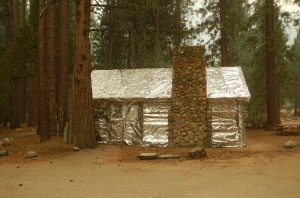 “Cabins and other cultural resources that can be destroyed by fire are wrapped with fire proof materials to protect them from the flames. Other cultural features that fire will not disturb but that fire suppression efforts such as line construction could or will destroy, are marked in advance so line construction personnel and equipment can avoid them.”
“Cabins and other cultural resources that can be destroyed by fire are wrapped with fire proof materials to protect them from the flames. Other cultural features that fire will not disturb but that fire suppression efforts such as line construction could or will destroy, are marked in advance so line construction personnel and equipment can avoid them.”
The same approach is taken for important natural features like the magnificent Sequoia’s and their groves on both National Forest and National Park lands.
“Resource Advisors have been monitoring all the sequoia groves in the fire area.” Linn explained. “Fire is a natural part of the giant sequoia ecosystem, however, this year with the severe drought conditions it was very important that the areas where the fire was destined to proceed through the sequoia groves, it did so with less intensity.”
Linn said that where the Rough Fire burned through sequoia groves in the National Forest, they survived and actually benefited from the effects of the fire.
“We expect to see something some of the groves have not experienced in a very long time: new seedlings in large numbers next spring. The years of accumulated needle and debris that fell on the forest floor was finally burned away to allow new seedlings to reach the soil and start germinating when the rains come.”
The sequoia’s are special in many ways. Additional special protection at the direction of the Resource Advisors was given to those considered national treasures to insure no damage or loss of these very special monarchs.
There is a special community of people with long ties to the lands affected by the Rough Fire. They are the Native American Indian communities of the Dunlap Band of the Mono Indians, the Traditional Choinumni Tribe, and the Cold Springs Rancheria of Mono (Holkoma). Forest Service Tribal Relation Liaison, Dirk Charley, whose family history is traced back before the settlers entered this area, is actively involved with the Resource Advisors on the Rough Fire. His and others with personal knowledge and ties to these lands are in turn an important resource to the Rough Fire Resource Advisors, and to the National Forests and Parks.
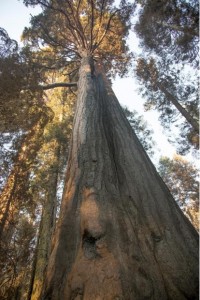 “Our people have served as “Resource Advisors” since before settlers came in to this area.” Dirk said. “We help the National Forests and Parks in identifying important cultural resources, and now I have been working together with Linn Gassaway and her team of specialists.”
“Our people have served as “Resource Advisors” since before settlers came in to this area.” Dirk said. “We help the National Forests and Parks in identifying important cultural resources, and now I have been working together with Linn Gassaway and her team of specialists.”
These lands are truly very special lands with very unique values. The Giant Sequoia’s – monarchs that each have withstood literally thousands of years of wildland fires – are a testament to perseverance and stability. The Rough Fire touched the land, consuming much in some areas, and providing just the right amount of affect to benefit other areas.
Regardless of where the Rough Fire was, in time the land will heal and new plant and animal communities will thrive. And along with them, people will continue to enjoy the wonders that still make up this this unique land of monarch trees and world class canyon.

